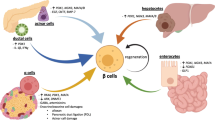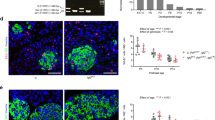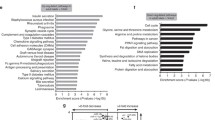Abstract
Diabetes results when there is an inadequate functional mass of pancreatic β-cells. In type 1 diabetes immune-mediated destruction of β-cells clearly leaves a markedly reduced β-cell mass, even though as much as 10-20% β-cells can be found in human pancreas after many years of disease (1). In type 2 diabetes, an increased demand for secreted insulin is not met in spite of the presence of β-cell mass that can be near normal. In MODY genetic defects result in impaired β-cell function that appears not to be adequately compensated for by an increase in f3-cell mass to maintain glucose homeostasis. Two types of compensation can occur: a functional one in which each ß-cell secretes more insulin and a second in which there is change of β-cell mass. Functional adaptations have been shown as changes in threshold for glucose-induced insulin secretion that occurs during pregnancy (2) and glucose-induced increases in glucokinase activity (3). Even so, the major factor in the amount of insulin that can be secreted is the β-cell mass itself. The mass of functional β-cells is dynamic and is regulated to maintain the blood glucose levels in a narrow physiological range. This chapter will describe the mechanisms involved; most of the data have been generated in rodent models but provide insights into what is likely to occur in humans.
Access this chapter
Tax calculation will be finalised at checkout
Purchases are for personal use only
Preview
Unable to display preview. Download preview PDF.
Similar content being viewed by others
References
Pipeleers D and Ling Z. Pancreatic beta cells in insulin-dependent diabetes. Diabetes Metab Rev 1992;8:209–227.
Sorenson, RL, Brelje TC, Hegre OD, Marshal S, Anaya P, and Sheridan JD. Prolactin (in vitro) decreases the glucose stimulation, enhances insulin secretion and increases dye coupling among islet β-cells. Endocrinology 1987;121:1447–1453.
Chen C, Hosokawa H, Bumbalo LM, and Leahy JL. Regulatory effects of glucose on the catalytic activity and cellular content of glucokinase in the pancreatic ß-cell. J Clin Invest 1994;94:1616–1620.
Hellerstrom C, Swenne I, and Andersson A. Islet cell replication and diabetes. In ThePathology of the Endocrine Pancreas in Diabetes. P. J. Lefebvre and D. G. Pipeleers, editors. Heidelberg, F.R.G., Springer-Verlag 1988;141–170.
Finegood DT, Scaglia L, and Bonner-Weir S. (Perspective) Dynamics of 13-cell mass in the growing rat pancreas: estimation with a simple mathematical model. Diabetes 1995;44:249–256.
Weaver CV, Sorenson RL, and Kaung HC. Immunocytochemical localization of insulinimmunoreactive cells in the ducts of rats treated with trypsin inhibitor. Diabetologia 1985;28:781–785.
Sarvetnick N, Shizuru J, Liggitt D, Martin L, McIntyre B, Gregory A, Parslow T, and Stewart T. Loss of pancreatic islet tolerance induced by beta cell expression of IFN-gamma. Nature 1990;346:844–847.
Rosenberg LA, Brown RA, and Duguid WP. A new approach to the induction of duct epithelial hyperplasia and nesidoblastosis by cellophane wrapping of the hamster pancreas. J Surg Res 1983;35:63–72.
Bonner-Weir S, Baxter LA, Schuppin GT, and Smith FE. A second pathway for regeneration of the adult exocrine and endocrine pancreas: A possible recapitulation of embryonic development. Diabetes 1993;42:1715–1720.
Xu G, Stoffers DA, Habener JF, and Bonner-Weir S. Exendin-4 stimulates both_t3-cell replication and neogenesis, resulting in increased [1-cell mass and improved glucose tolerance in diabetic rats. Diabetes 1999;48:2270–2276.
Walker NI, Winterford CM, and Kerr JFR. Ultrastructure of the rat pancreas after experimental duct ligation. II. Duct and stromal cell proliferation, differentiation, and deletion. Pancreas 1992;7:420–434.
Scaglia L, Smith FE, and Bonner-Weir S.. Apoptosis contributes to the involution of 13-cell mass in the post partum rat pancreas. Endocrinology 1995;136:5461–5468.
Scaglia L, Cahill CJ, Finegood DT, and Bonner-Weir S. Apoptosis participates in the remodelling of the endocrine pancreas in the neonatal rat. Endocrinol 1997;138:1736–1741.
Bonner-Weir S, Deery D, Leahy JL, and Weir GC. Compensatory growth of pancreatic ß-cells in adult rats after short-term glucose infusion. Diabetes 1989;38:49–53.
Pick A, Clark J, Kubstrup C, Pugh W, Bonner-Weir S, and Polonsky K. Role of apoptosis in failure of ß-cell mass compensation for insulin resistance and 0-cell defects in the male Zucker diabetic fatty (ZDF) rat. Diabetes 1998;47:358–364.
Pick A, Levisetti M, Baldwin A, and Bonner-Weir S. Failure of ß-cell mass compensation for insulin resistance in dexamethasone induced diabetes in female Zucker diabetic fatty (ZDF) rats. Diabetes 1998;47 Suppl 1:A258.
Jonas J-C, Sharma A, Hasenkamp W, Ilkova H, Patane G, Laybutt R, Bonner-Weir S, and Weir GC. Chronic hyperglycaemia triggers loss of pancreatic ß-cell differentiation in an animal model of diabetes. J Biol Chem 1999;274:14112–14121.
Wolf G. Molecular mechanisms of renal hypertrophy: role of p27K’P’. Kidney Int. 1999;56:1262–1265.
Bouwens L, Lu WG, and Krijger RD. Proliferation and differentiation in the human fetal endocrine pancreas. Diabetologia 1997;40:398–404.
Bouwens L and Pipeleers DG. Extra-insular beta cells associated with ductules are frequent in adult human pancreas. Diabetologia 1998;41:629–633.
Lefebvre V, Otonkoski T, Ustinov J, Huotari M, Pipeleers D, and Bouwens L. Culture of adult human islet preparations with hepatocyte growth factor and 804G matrix is mitogenic for duct cells but not for beta-cells. Diabetes 1998;47:134–137.
Kaung H-LC. Growth dynamics of pancreatic islet cell populations during fetal and neonatal development of the rat. Dev Dyn 1994;200:163–175.
Kloppel G, Lohr M, Habich K, Oberholzer M, and Heitz PU. Islet pathology and the pathogenesis of type 1 and type 2 diabetes mellitus revisited. Sury Synth Pathol Res 1985;4:110–125.
Bonner-Weir S and Like, AA. A dual islet population in bovine pancreas. Cell Tissue Res 1980;206:157–170.
Montanya E, Nacher V, Biarnes M, and Soler J. Linear correlation between beta cell mass and body weight throughout life in Lewis rats: role of beta cell hyperplasia and hypertrophy. Diabetes 2000;49:(In Press)
Bonner-Weir S. Islet growth and development in the adult. J Mol Endocrinol 2000;24:1–6.
Rabinovitch A, Suarez-Pinzon WL, Shi Y, Morgan AR, and Bleackley RC. DNA fragmentation s an early event in cytokine-induced islet beta-cell destruction. Diabetologia 1994;37:733–738.
Ledda-Columbano GM, Columbano A, Coni P, Fao G, and Pani P. Cell deletion by apoptosis during regression of renal hyperplasia. Am J Physiol 1989;135:657–662.
Parsons JA, Brelje TC, and Sorenson RL. Adaptation of islets to pregnancy: Increased islet cell proliferation and insulin secretion correlates with the onset of placental lactogen secretion. Endocrinology 1992;130:1459–1466.
Parsons JA, Bartke A, and Sorenson RL. Number and size of islets of Langerhans in pregnant human growth hormone-expressing transgenic, and pituitary dwarf mice: effect of lactogenic hormones. Endocrinology 1995;136:2013–2021.
Marynissen G, Aerts L, and Van Assche FA. The endocrine pancreas during pregnancy and lactation in the rat. J Devel Physiol 1983;5:373–381.
Marynissen G, Malaisse WJ, and Van Assche FA. Influence of lactation on morphometric and secretory variables in pancreatic ß-cell of mildly diabetic rats. Diabetes 1987;36:883–891.
Bruning JC, Winnay J, Bonner-Weir S, Taylor SI, Accili D, and Kahn CR. Development of a novel polygenic model of NIDDM in mice heterozygous for IR and IRS-1 null alleles. Cell 1999;88:561–572.
Bonner-Weir S, Leahy JL, and Weir GC. Induced rat models of non-insulin-dependent diabetes mellitus. In Lessons from Animal Diabetes II. E. Shapiro and A. E. Renold, editors. John Libbey, London. 1998;295–300.
Leahy JL, Cooper HE, and Weir GC Impaired insulin secretion associated with near normoglycaemia: study in normal rats with 96-h in in vivo glucose infusions. Diabetes 1987;36:459–464.
Bernard C, Berthault M-F, Saulnier C, and Ktorza A. Neogenesis vs. apoptosis as main components of pancreatic ß-cell mass changes in glucose-infused normal and mildly diabetic adult rats. FASEB J 1999;13:1195–1205.
Preisig P. What makes cells grow larger and how do they do it? Exp Nephrol 1999;7:273–283.
Franch HA, Shay JW, Alpern RI, and Preisig PA. Involvement of pRB family in TGF ß-dependent epithelial cell hypertrophy. J Cell Biol 1995;129:245–254.
Bonner-Weir S. and Smith FE. Islet cell growth and the growth factors involved. Trends Endocrinol Meta 1994;5:60–64.
Leahy JL, Bonner-Weir S, and Weir GC. 0-cell dysfunction induced by chronic hyperglycaemia: Current ideas on mechanism of impaired glucose-induced insulin secretion. Diabetes Care 1992;15:442.
Madden ME and Sarras, Jr MP. The pancreatic ductal system of the rat: cell diversity, ultrastructure, and innervation. Pancreas 1989;4:472–485.
Gepts W. Pathological anatomy of the pancreas in juvenile diabetes. Diabetes 1965;14:619–633.
Rutter WJ, Pictet RL, Harding JD, Chirgwin JM, MacDonald RJ, and Przybyla AE. An analysis of pancreatic development: Role of mesenchymal factor and other extracellular factors. Sym Soc Dev Biol 1978;35:205–207.
Gittes GK, Galante PE, Hanahan D, Rutter WJ, and Debase HT. Lineage-specific morphogenesis in the developing pancrease: role of mesenchymal factors. Development 1996;122:439–447.
Michalopoulos GK. Liver regeneration: molecular mechanisms of growth control. FASEB J 1990;4:176–187.
Streuli CH. Extracellular matrix remodelling and cellular differentiation. Current Opin Cell Biol 1999;11:634–640.
Petersen BE, Bowen WC, Patrene KD, Mars WM, Sullivan AK, Murase N, Boggs SS, Greenberger JS, and Goff JP. Bone marrow as a potential source of hepatic oval cells. Science 1999;284:1168–1170.
Farber E. The multistep nature of cancer development. Cancer Res 1984;44:4217–4223.
Evans RP, Nagy P, Marsden E, and Thorgeirsson SS. A precursor-product relationship exists between oval cells and hepatocytes in rat liver. Carcinogenesis 1987;8:1737–1740.
Bonner-Weir S, Stubbs M, Reitz P, Taneja M, and Smith FE. Partial pancreatectomy as a model of pancreatic regeneration. In Pancreatic Growth and Regeneration. N. Sarvetnick, editor. Karger Landes Systems, 1997;138–153.
Sharma A, Zangen DH, Reitz P, Taneja M, Lissauer ME, Miller CP, Weir GC, Habener JF, and Bonner-Weir S. The homeodomain protein IDX-1 increases after an early burst of proliferation during pancreatic regeneration. Diabetes 1999;48:507–513.
Wolf G, Schroeder R, Ziyadeh FN, Thaiss F, Zahner G, and Stahl RAK. High glucose stimulates expression of P27’0 in cultured mouse mesangial cells: relationship to hypertrophy. Am J Physiol 1997;42:F348–F356.
Preisig P. A cell cycle-dependent mechanism of renal tubule epithelial cell hypertrophy. Kidney Int 1999;56:1193–1198.
Wang Y, Huang S, Sah VP, Ross Jr J, Brown JH, Hans J, and Chien KR. Cardiac muscle cellhypertrophy and apoptosis induced by distinct members of the p38 mitogen-activated protein kinase family. J Biol Chem 1998;273:2161–2168.
Hunter JJ and Chien KR. Signalling pathways for cardiac hypertrophy and failure. N Engl J Med 1999;341:1276–1283.
Braun-Dullaeus RC, Mann MJ, Ziegler A, von der Leyen HE, and Dzau VJ. A novel role for the cyclin-dependent kinase inhibitor p27(kip1) in angiotensin II-stimulated vascular smooth muscle cell hypertrophy. J Clin Invest 1999;104:815–823.
Norman JT, Bohman RE, Fischmann G, Bowen JW, McDonough A, Slamon D, and Fine LG. Patterns of mRNA expression during early cell growth differ in kidney epithelial cells destined to undergo compensatory hypertrophy versus regenerative hyperplasia. Proc Natl Acad Sci USA 1998;85:6768–6772.
Evan GI, Wyllie AH, Gilbert CS, Littlewood TD, Land H, Brooks M, Waters CM, Penn LZ, and Hancock DC. Induction of apoptosis in fibroblasts by c-myc protein. Cell 1992;69:119–128.
Leiter EH, Gapp DA, Eppig JJ, and Coleman DL. Ultrastructural and morphometric studies of delta cells in pancreatic islets from C57BL/Ks diabetes mice. Diabetologia 1979;17:297–309.
Gross DJ, Leibowitz G, Cerasi E, and Kaiser N. Increased susceptibility of islets from diabetes-prone psammomys obesus to the delterious effects of chronic glucose exposure. Endocrinol 1996;137:5610–5615.
Laybutt DR, Hasenkamp W, Groff A, Jonas J-C, Kaneto H, Grey S, Ferran C, Sharma A, Bonner-Weir S, and Weir GC. Activation of protective and destructive stress genes accompanies beta cell hypertrophy in hyperglycemic rats. Diabetes 2000;49:Suppl 1:(In Press)
Author information
Authors and Affiliations
Editor information
Editors and Affiliations
Rights and permissions
Copyright information
© 2001 Springer Science+Business Media New York
About this chapter
Cite this chapter
Bonner-Weir, S., Weir, G.C. (2001). Mechanisms of Postnatal β-Cell Mass Regulation. In: Habener, J.F., Hussain, M.A. (eds) Molecular Basis of Pancreas Development and Function. Endocrine Updates, vol 11. Springer, Boston, MA. https://doi.org/10.1007/978-1-4615-1669-9_17
Download citation
DOI: https://doi.org/10.1007/978-1-4615-1669-9_17
Published:
Publisher Name: Springer, Boston, MA
Print ISBN: 978-1-4613-5669-1
Online ISBN: 978-1-4615-1669-9
eBook Packages: Springer Book Archive




